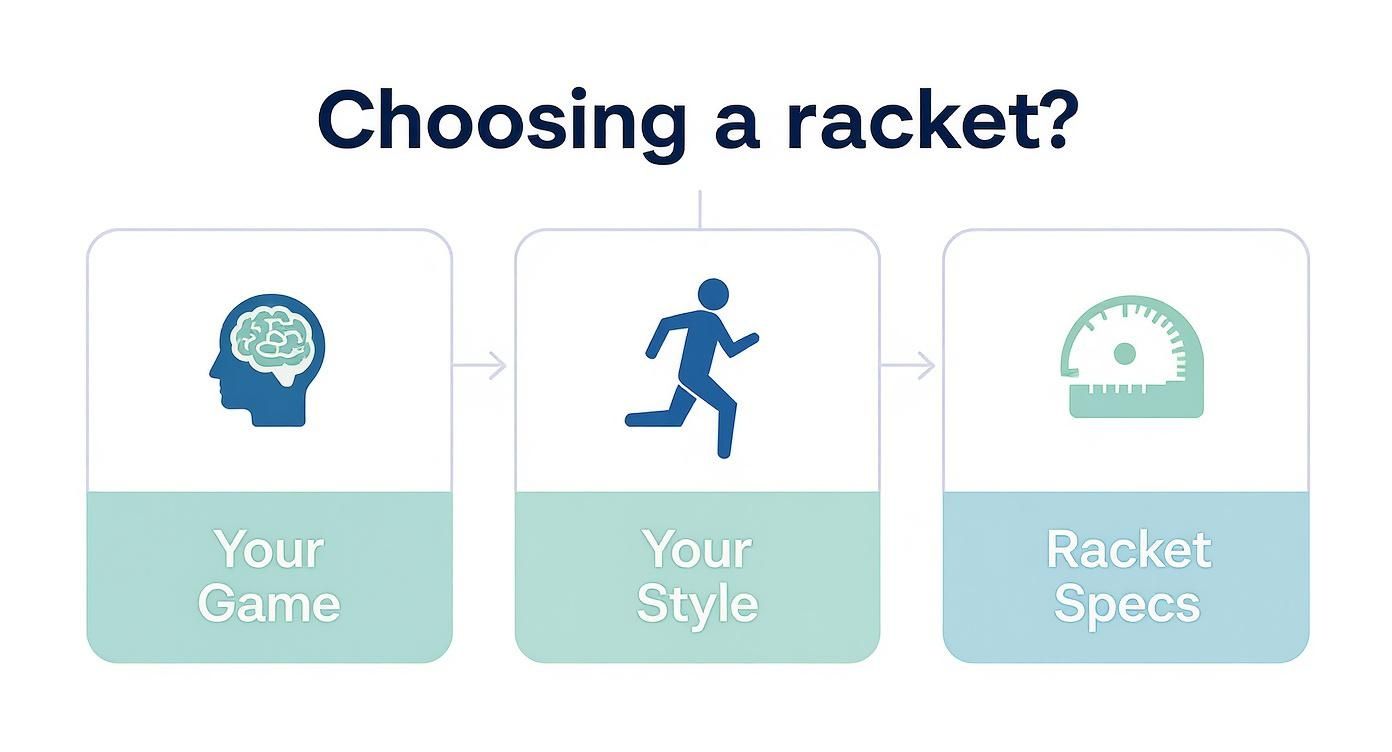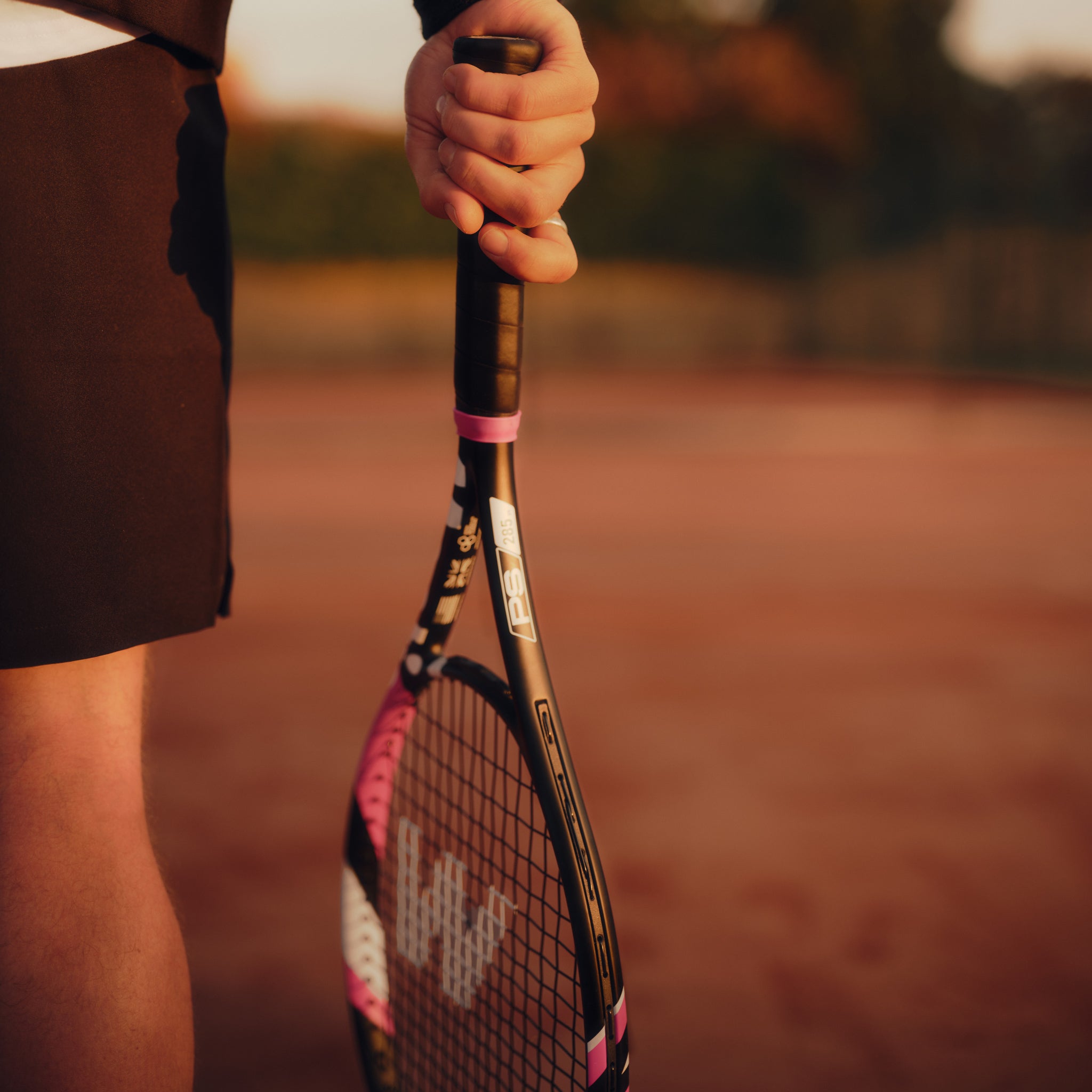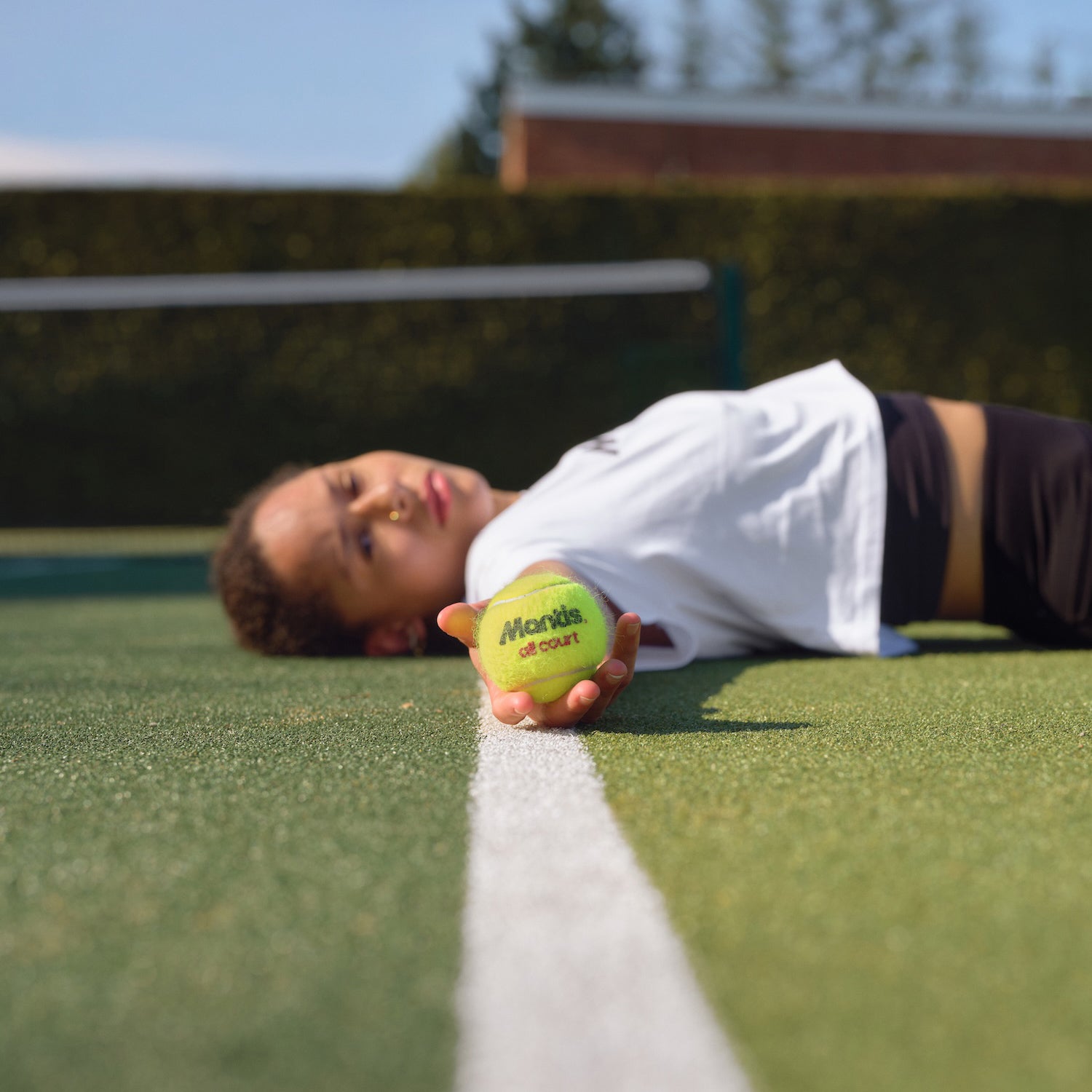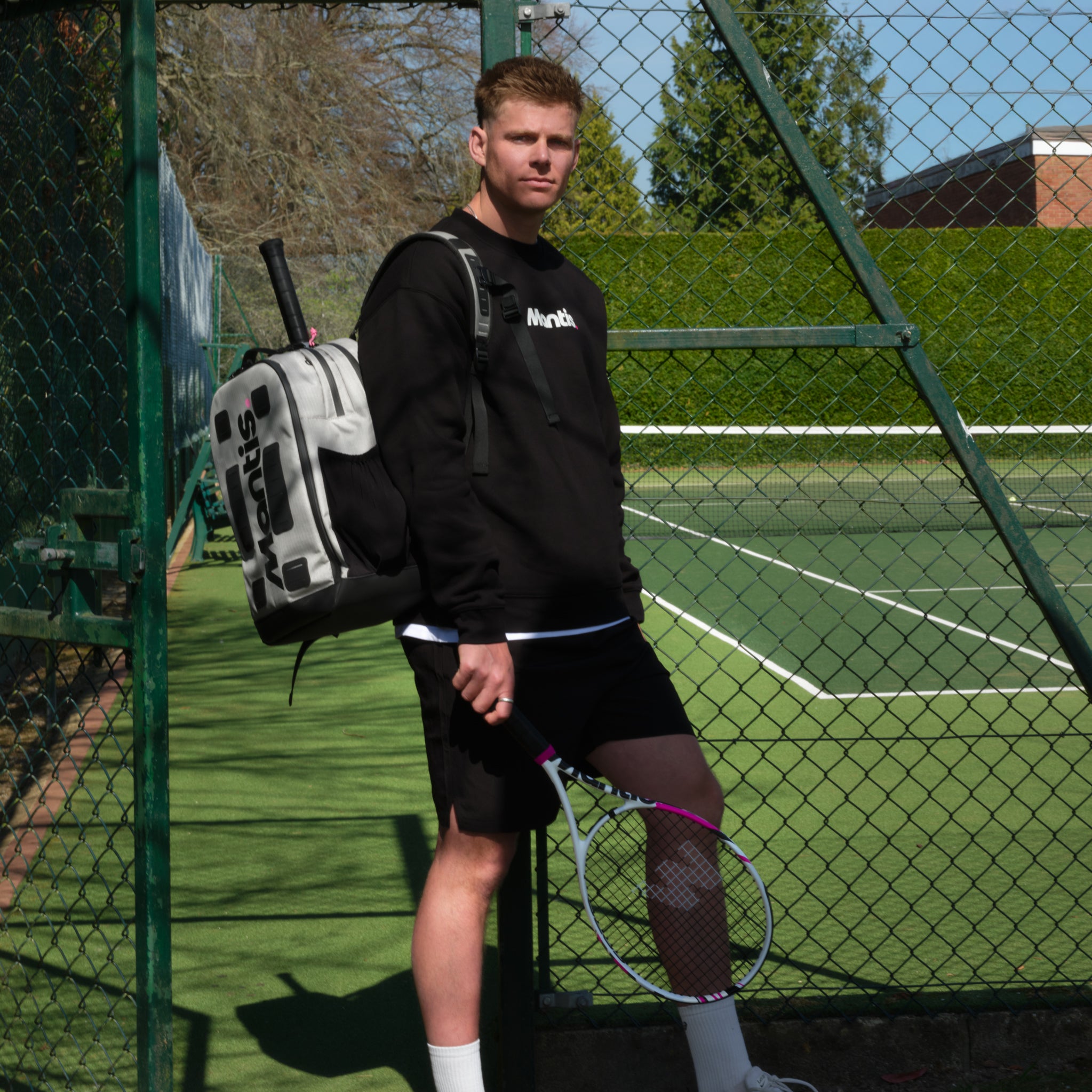
Picking the right tennis racket is all about finding a frame that complements your unique game. It’s a bit of a matching game, really—aligning the racket’s specs with your skill level, playing style, and physical strength. The goal when deciding on how to choose a racket is to find something that feels less like a piece of equipment and more like a natural extension of your arm. Once you have your racket sorted, you can focus on perfecting your tennis serve.
Finding Your Perfect Match on the Court
Choosing a new racket can seem overwhelming with all the tech talk and marketing noise. Here at Mantis, we prefer to cut through the clutter. Let's focus on the practical steps that will actually help you find a frame that elevates your strengths and helps you improve.
Think of this guide as your roadmap to a confident decision. This whole process starts not in a shop, but right on the court with an honest look at your own game.
Starting with a Good, Honest Self-Assessment
Before you even look at a single racket, you need to understand your own game. Are you a beginner, still getting the hang of things and working on consistency? Or are you a seasoned player who likes to control the point from the first ball?
This is crucial because the racket that suits a novice is worlds apart from what an advanced competitor needs.
Your playing style is just as important. Do you love to hang back at the baseline and grind out long rallies? Or are you always looking for that short ball to come in and attack the net? Be honest with yourself. These answers are the blueprint for the racket you should be looking for.
Choosing a racket isn't about finding the "best" one on the market; it's about finding the best one for you. A racket that works wonders for a professional might be completely unsuitable for a club player, and vice-versa.
Ultimately, you want a frame that works with you, not against you. The right match can do wonders for your confidence, help you make shots you didn't think you could, and even lower your risk of injury. Taking a moment for this self-reflection makes the entire search so much more effective.
The Ever-Changing World of Racket Tech
It's a fantastic time to be in the market for a new racket. Technology is constantly evolving, and the UK lawn-tennis racket market reflects that excitement. It was valued at around $60.8 million in 2022 and is expected to climb to nearly $62 million in 2023.
What's driving this? A couple of things. New materials are giving players incredible shot control, and big global tournaments are firing up public interest. On top of that, manufacturers are getting serious about sustainability, using eco-friendly materials to meet the demand from players like us. You can explore more data about the growing UK tennis market from industry analysis.
How to Choose a Racket That Matches Your Game
Before you even think about head sizes or balance points, the best place to start is with an honest look in the mirror. Where are you really at with your game? Understanding your current skill level and natural playing style is the absolute foundation for choosing a racket that will help, not hinder, your progress.
A frame designed for a tour professional who generates their own blistering pace will feel like an unwieldy plank of wood to a beginner. On the flip side, the light, forgiving racket that helps a novice find their rhythm will feel flimsy and unstable in the hands of an advanced player. It's all about finding the right tool for the job.
What Kind of Player Are You?
Let’s get straight to it. Figuring out which of these profiles best describes you will instantly narrow down your options and point you in the right direction.
- The Beginner: You're new to tennis or only play a handful of times a year. Your main goal is simple: make clean contact, get the ball over the net, and keep a short rally going. Your swings are still developing and are often shorter and a bit slower.
- The Intermediate Player: You're playing regularly and have developed some solid, reliable strokes. You can place the ball with a decent amount of intention, you're starting to use spin, and your serve is becoming a weapon. Strategy is now part of your game.
- The Advanced Player: You’ve been playing for years, maybe even competitively. Your technique is second nature, you generate your own power with ease, and you have a full toolbox of shots to build points. You're likely looking for a racket that gives you ultimate control and feel.
This handy decision tree shows how your game leads you to the right racket specs.

As you can see, it's a logical path. You start by looking at your own game and style, which then informs the technical details you should be looking for in a racket.
What’s Your On-Court Personality?
Skill level is only half the story. How do you actually like to win points? Your playing style is a huge clue as to what you'll need from a frame. Most players fall into one of these camps (or a mix of a couple).
The Aggressive Baseliner
You live at the back of the court, hitting heavy groundstrokes and pushing your opponent around. Your game is built on relentless pace and depth, forcing errors or setting up an easy winner. You'll need a stable racket that can handle that power and plow through the ball.
The Counter-Puncher
Consistency and defence are your bread and butter. You’re a human backboard, using your speed to track down every shot and frustrate your opponent into making a mistake. A control-oriented racket with a generous sweet spot will be your best friend.
The All-Court Player
You're a true chameleon, comfortable slugging it out from the baseline, attacking the net, or mixing in slices and drop shots. Your game demands versatility, so you need a racket that does a little bit of everything well—a blend of power, control, and feel.
The Serve-and-Volleyer
A throwback to a classic, aggressive style. You follow your big serve into the net, looking to end the point with a crisp volley. A lightweight, head-light racket that’s quick to manoeuvre at the net is essential for this fast-paced game.
Honesty is your best policy here. Don't buy a racket for the player you hope to be in two years. Choose a frame that works for the player you are today. The right racket will actually help you get to that next level much faster.
To give you a clearer picture, here’s a table that summarises which racket specs generally align with each player level.
Racket Recommendations by Player Level
This table breaks down the typical racket characteristics that benefit players at different stages of their tennis journey.
| Player Level | Primary Goal | Recommended Head Size (sq. in.) | Recommended Weight (grams, unstrung) | Recommended Balance |
|---|---|---|---|---|
| Beginner | Power & Forgiveness | 102+ | 255-280 | Head-Heavy (HH) |
| Intermediate | Blend of Power & Control | 98-102 | 280-310 | Even Balance (EB) to Head-Light (HL) |
| Advanced | Control & Feel | 95-98 | 310+ | Head-Light (HL) |
Think of these as reliable starting points, not rigid rules. An intermediate aggressive baseliner will look for something different than an advanced all-court player.
By figuring out your own unique profile first, you’re ready to dive into the nitty-gritty of racket specs without getting lost or distracted by marketing hype. You now have a filter to find a frame that’s truly in sync with how you play.
Getting to Grips with Racket Specs: Head Size, Weight, and Balance
Alright, this is where we get into the nuts and bolts of what makes a racket perform the way it does. Understanding the specifications on the side of the frame is the key to matching a piece of equipment to your unique style of play.
We're going to focus on the big three: head size, weight, and balance. Think of these as the primary ingredients that determine a racket's power, control, and overall feel in your hand.
If you really want to dive deep, our detailed guide to racket specifications is a great place to start. For now, let’s break down how these three core specs influence your game.
What Does Head Size Actually Do?
Simply put, the head size dictates the size of your hitting area and its "sweet spot."
A larger head (think 105 sq inches and up) is more forgiving. If you don't always strike the ball perfectly in the centre, this extra surface area gives you a much bigger margin for error and a nice boost of power. On the flip side, a smaller head (anything under 100 sq inches) rewards precision. Players who consistently find the middle of the strings love the pinpoint control these frames offer.
Here’s a quick reference:
| Head Size Category | Power Level | Forgiveness | Control |
|---|---|---|---|
| Oversize (105+ sq in) | High | High | Moderate |
| Midplus (98–104 sq in) | Balanced | Balanced | Good |
| Midsize (<98 sq in) | Low | Low | High |
So, a club player who struggles with off-centre hits would find an oversize frame a huge help in reducing those frustrating mishits. Meanwhile, an advanced baseliner will often gravitate towards a midsize head for the surgical placement it allows.
Finding the Right Weight for Your Game
The weight of a racket is crucial. It directly affects how quickly you can swing it and how stable it feels when you make contact with the ball.
Lighter frames (generally under 285g unstrung) are easy to swing, making them great for quick reactions at the net and reducing fatigue during long matches.
- Under 285g: Perfect for juniors developing their technique or club players who value manoeuvrability above all else.
- 285g–310g: This is the sweet spot for most intermediate players, offering a fantastic blend of swing speed and stability.
- Above 310g: Reserved for advanced and competitive players who have the strength to handle the extra mass, which provides incredible "plough-through" and shot depth.
A word of caution: jumping to a heavy racket too soon is a common mistake. It demands a lot more from your arm and can lead to strain or injury if your body isn't ready for it. When you're demoing rackets, make sure to hit a variety of shots to really feel how the weight impacts your entire game.
The Feel of the Racket: Balance and Manoeuvrability
Balance is all about where the weight is distributed along the racket. You'll see it described as "head-light," "head-heavy," or "evenly balanced."
A head-light racket (where more weight is in the handle) feels whippy and quick, which is a massive advantage for fast exchanges at the net. A head-heavy frame, with more weight in the hoop, helps generate momentum on groundstrokes from the baseline.
"Switching to the right balance completely transformed my volley game. It just felt so much faster in my hands."
- Coach Sarah Mills
Players who do a bit of everything often feel most comfortable with an evenly balanced racket, as it provides a versatile foundation for any shot.
Putting It All Together: Real Player Examples
Let’s see how this works in the real world.
-
The Club Beginner: Struggling with consistent contact, they find their confidence soars with a forgiving 106 sq in head and a light 260g frame. The huge sweet spot makes tennis fun again.
-
The Intermediate Baseliner: This player loves grinding from the back of the court. A 100 sq in midplus head, a 300g weight, and a slightly head-light balance give them the ideal mix of spin potential and stability.
-
The Advanced All-Courter: Needing a racket that performs everywhere, they opt for a player's frame: 98 sq in head for precision, 320g for stability, and an even balance for versatility on baseline rallies and net attacks.
The Final Touch: Strings and Tension
Once you’ve dialled in the specs, don't forget about the strings! This is how you can fine-tune the feel and performance even further.
- For extra comfort and a softer feel, start with a multifilament or synthetic gut string.
- A good starting tension is between 50–54 lbs, which offers a great blend of power and control.
- Consider a hybrid setup (polyester in the mains, a softer string in the crosses) if you're looking for more spin without sacrificing too much comfort.
How the Specs Work Together
Remember, these specs don't exist in a vacuum. Changing one will always affect the others.
For example, making the head size larger without adding weight will naturally make the racket feel more head-light, improving manoeuvrability. Adding 10g of weight to the tip of the racket has a much more dramatic effect on the swing weight than adding that same 10g to the handle. It’s this intricate dance between specs that creates the unique feel of each racket.
The goal is to find the combination of specs that feels like a natural extension of your arm.
By arming yourself with this knowledge, you can walk into a demo session with a clear idea of what to look for, ultimately finding that perfect balance of power and control for your game.
How Strings and Stiffness Shape Your Game
While the head size, weight, and balance grab all the headlines, two other specs play a massive supporting role in how a racket actually feels and performs: the string pattern and the frame stiffness. Getting these right is about fine-tuning the racket to your personal stroke mechanics, and it can be the difference between a racket that feels good and one that feels like a true extension of your arm.
These details are where the real magic happens. For a much deeper dive into the world of strings themselves, our comprehensive tennis string guide is packed with information to help you get it right. Understanding how all these pieces fit together is a massive part of learning how to choose a racket that genuinely elevates your game.
The Great String Pattern Debate
The string pattern is simply the number of main (vertical) and cross (horizontal) strings in the racket head. You'll almost always see two common setups: 16x19 and 18x20. The difference might not look like much, but the effect on court is night and day.
An open string pattern, like a 16x19, means there’s more space between each string. This lets the stringbed physically bite into the ball more, allowing it to snap back and generate a ton of spin. If you're a player who loves hitting with heavy topspin, you’ll probably find yourself drawn to open patterns. They help create a higher launch angle, making it easier to get the ball to dip aggressively back down inside the baseline.
On the flip side, a dense string pattern, like an 18x20, packs more strings into the exact same area. This creates a much firmer, more connected feel at impact. The ball doesn't sink into the strings quite as deeply, which gives you a lower launch angle and a real sense of directional control. Players who hit a flatter ball and prioritise precision often swear by the direct feedback they get from a dense pattern.
Think of it this way: an open pattern is like having deep treads on a tyre—it grips the road (the ball) for better traction and spin. A dense pattern is more like a racing slick, offering a more direct, controlled, and precise connection with the surface.
Understanding Frame Stiffness and its Impact
Frame stiffness, measured by its RA (Racket Analysis) rating, tells you how much the racket frame bends when you hit the ball. This single number has a huge say in the racket's power, control, and, importantly, its comfort.
-
Stiff Frames (RA 70+): A stiffer frame deforms less on impact, which means it returns more energy back to the ball. The result? More free power. But that power comes at a cost—they also send more shock and vibration up your arm, which can be a deal-breaker for some players.
-
Flexible Frames (RA below 65): A more flexible frame bends more when it meets the ball, pocketing it for a split second longer. This increased "dwell time" is what many players describe as better feel and control. They also absorb a lot more of the impact shock, making them far easier on the arm.
The current trend in the UK, which holds about 13.32% of Europe's tennis racket market, is a move towards frames that blend these characteristics cleverly. Players are looking for that sweet spot of stability and feel, and manufacturers are responding with designs that really dial in the combination of string pattern and stiffness for different playing styles.
Finding Your Ideal Combination
The perfect setup is all about balancing these two elements with your swing and what your body can handle. There are no hard-and-fast rules, but here are a few common player profiles and the setups that usually click for them.
The Modern Baseliner
This player lives at the back of the court, building points with heavy topspin.
- Ideal Combo: An open (16x19) string pattern is a must for that spin potential. Pair it with a moderately flexible frame (RA 65-69) for a nice blend of power and feel that isn't too harsh on the arm.
The Classic Flat Hitter
This player values precision, driving through the ball with a flatter, more linear swing.
- Ideal Combo: A dense (18x20) string pattern gives them the laser-like directional control they crave. Matching it with a flexible frame (RA below 65) provides the crucial feel and comfort needed for such a precise game.
The Player with Arm Sensitivities
For this player, comfort is everything. They might have a history of tennis elbow or other arm issues.
- Ideal Combo: A very flexible frame (RA below 64) is non-negotiable. From there, they could go with either string pattern—open for more forgiveness and easy spin, or dense if they still want that pinpoint control without the jarring feedback of a stiff frame.
Ultimately, it comes down to what you prioritise on court. Do you need more spin to help your big shots find the court, or are you looking for that surgical precision to paint the lines? Answering that question will point you directly to the right string pattern and stiffness for your game.
Why You Must Demo Before You Buy
Reading specs on a website is one thing; feeling the racket connect with the ball is something else entirely. We believe this is, without a doubt, the most critical step in finding the right frame. All the research in the world is just theory until you put it into practice on the court.
Think of demoing as an insurance policy against a costly mistake. A racket that looks perfect on paper might feel sluggish, overly stiff, or just plain wrong in your hand. This is where you validate your research and confirm that you’ve found the perfect partner for your game.
(And if you're helping your child find their first proper frame, our guide on choosing a junior tennis racket can help you through that specific process.)
Creating a Smart Demo Plan
The goal here isn't to hit with every racket in the shop. That’s a recipe for confusion. Based on the player profile you’ve built, you should aim to narrow your choices down to just three or four frames. This is a manageable number that lets you do a proper comparison without getting overwhelmed.
Once you have your top contenders, the real work begins. You need to give each racket a fair and thorough trial.
- Book enough court time: Plan to hit with each racket for at least one full hour. Anything less isn’t enough to get a real feel.
- Use your usual strings and tension: Consistency is key. If you can, ask the shop to string the demos with your preferred string at your usual tension. This creates a level playing field.
- Play, don't just drill: It’s essential to use the racket in real match-play situations. A frame can feel great in a casual rally but completely different when you're under pressure.
This structured approach is the only way to get a true sense of how each racket really performs.
What to Look for During Your On-Court Test
As you play, keep a mental checklist. You’re trying to get a sense of how the racket feels and performs across every part of your game. It’s not just about that one cracking forehand; it’s about the complete picture.
Pay close attention to these specific areas:
- Groundstrokes: Can you generate the spin you want? Is depth coming easily, or are you having to muscle the ball? Notice how it feels when you’re stretched out wide or defending a heavy shot.
- Serves and Returns: How’s the pop on your first serve? More importantly, do you feel you can place your second serve with confidence? A big one is the return – is the racket stable enough to block back a big serve?
- Net Play: How quick does the frame feel on reaction volleys? Does it have enough touch for delicate drop shots and sharp angles?
- Overall Comfort: After an hour of hitting, how does your arm feel? Take note of any unusual vibrations or discomfort. That could be a serious red flag for long-term arm health.
A great racket shouldn't just feel good when you hit the sweet spot; it should also be forgiving and stable when you don't. Pay attention to how the frame responds on those inevitable off-centre hits.
By systematically going through this process, you’ll move beyond a vague "I like this one" feeling to a solid understanding of each racket's strengths and weaknesses for your game.
Finalising Your Decision
After you've tested all your options, one or two rackets will almost certainly stand out. Now is the time to trust your gut, backed by the on-court evidence you’ve just gathered. The best choice is the one that gives you the most confidence to hit your shots without even thinking about the equipment in your hand.
If you’re still on the fence, it can be helpful to get some outside perspective. Reading in-depth analysis from industry experts at a site like Racket Business can be a great way to confirm your feelings or perhaps highlight a detail you might have missed.
Ultimately, this on-court testing is the non-negotiable final step. It’s what connects all your careful research to real-world performance, ensuring the racket you finally choose truly feels like it was made for you.
Still Have Questions About Choosing a Racket?
Even after all the research and hitting a few balls, some nagging questions can pop up just as you're about to make a decision. We get it. At Mantis, we want you to be completely confident in your new frame, so let’s tackle some of the most common queries we hear from players like you.
And for those of you guiding a young player's journey, we’ve put together a specialised guide on choosing a junior tennis racket that covers the unique questions that come with the territory.
Let's clear up any last-minute doubts.
How Often Should I Actually Buy a New Racket?
This is probably the most common question we hear, and the honest answer is: it depends on how much you play. If you're a serious player hitting the courts a few times a week, a good rule of thumb is to look at replacing your main racket every two to three years.
It’s not really about dings and scratches. The real issue is that over hundreds of hours of hitting, the composite materials inside the frame—the graphite and carbon fibre—start to lose their magic at a microscopic level. This material fatigue means the frame just doesn't perform like it used to.
You'll start to feel it. The racket might feel a bit 'dead' or less responsive on contact. You might notice a drop in power, more vibration travelling up your arm, or even tiny stress marks on the frame itself. When those signs appear, your racket has served you well, but it's time for an upgrade.
Does Grip Size Really Matter That Much?
Yes, a thousand times yes! The importance of the right grip size is impossible to overstate. It’s one of those details that has a huge impact on your technique, comfort, and even your risk of getting injured.
Playing with the wrong size can cause more trouble than you’d think. A grip that's too small forces you to squeeze the handle like a vice just to keep it from twisting. That constant muscle tension is a fast track to forearm fatigue and is a notorious cause of tennis elbow.
On the other hand, a grip that's too big feels clumsy and seriously restricts what your wrist can do. This makes it incredibly difficult to generate the racket head speed and wrist snap you need for powerful serves and heavy topspin. Nailing your grip size is fundamental for both your performance and your long-term arm health.
Think of it this way: your grip is the one and only connection between you and your racket. Getting this single detail right is the foundation for comfortable, confident, and injury-free tennis.
Should I Bother with a Different Racket for Doubles?
For many players, having a dedicated doubles frame can absolutely give them an edge. Doubles is a different beast to singles, isn't it? The game is faster, the points are shorter, and having lightning-quick reflexes at the net often decides the match.
With that in mind, a lot of doubles specialists opt for a racket that is lighter and more head-light than their singles stick. This kind of spec makes the racket far more manoeuvrable, which is a lifesaver during those frantic, rapid-fire volley exchanges at the net.
While a big serve is always a plus, the focus in doubles often shifts to speed and responsiveness. A dedicated doubles racket can genuinely sharpen your reactions and help you dominate the net—which is exactly where most doubles matches are won and lost.
How Do I Know When It’s Time to Restring?
The classic advice was to restring as many times a year as you play per week. That's still a decent starting point, but modern polyester strings have completely changed the game.
Polys lose their tension much, much faster than the old synthetic gut or natural gut strings. This means they can feel 'dead' and perform poorly long before they actually break.
Keep an eye out for these tell-tale signs:
- You find yourself swinging harder just to get the ball to your usual depth.
- The string bed feels stiff and 'board-like' at impact, losing that satisfying pop.
- You're struggling with control, with more of your shots sailing long.
- Your arm starts feeling sore after a match because the dead strings are sending more shock up your arm.
As a general guideline, if you're a competitive player using poly strings, you should probably be restringing every 15-20 hours of play to keep your racket feeling and performing its best.
At Mantis, we live and breathe tennis. We're dedicated to engineering high-performance equipment that helps you play your best. Our rackets are built with precision and a deep understanding of what players truly need on the court.










